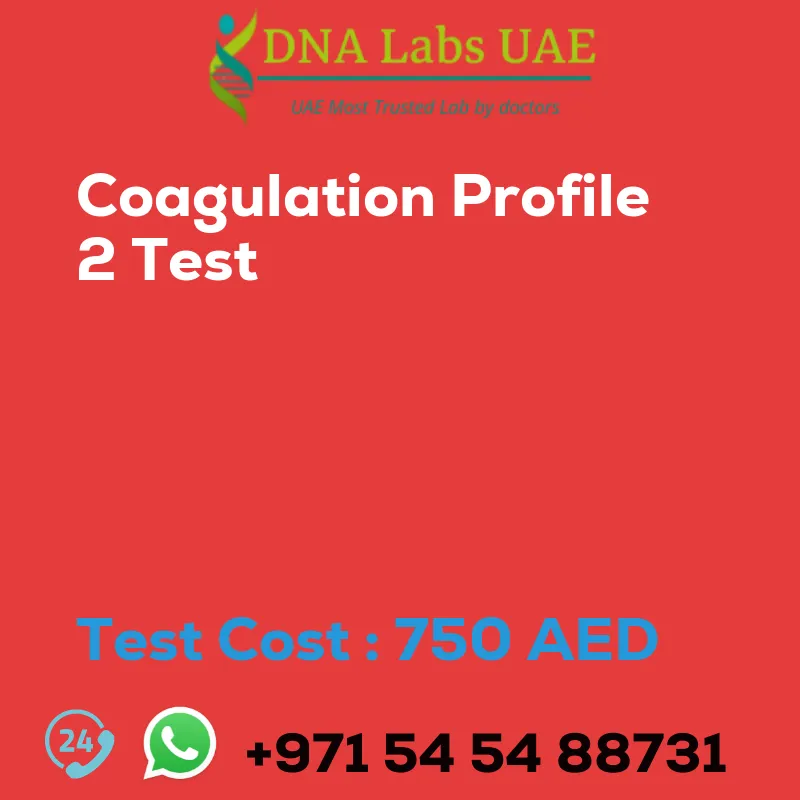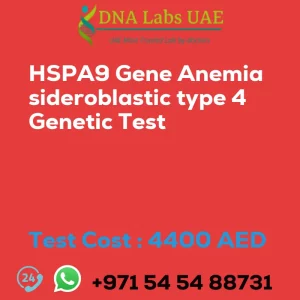COAGULATION PROFILE 2 Test
The Coagulation Profile 2 test is a comprehensive blood test that evaluates a person’s coagulation system. It measures various clotting factors and other parameters to assess the overall ability of blood to form and dissolve clots.
Test Components
- CBC
- BT
- CT
- Prothrombin studies
- APTT
- Thrombin Time
- Factor VIII Functional
Price
Test cost: 750.0 AED
Sample Condition
3 mL (1.5 mL min.) whole blood in 1 Lavender Top (EDTA) tube. Ship refrigerated. DO NOT FREEZE and 3 mL whole blood in 1 Blue Top (Sodium Citrate) tube. Mix thoroughly by inversion. Transport to Lab within 4 hours. If this is not possible, make PPP within 1 hour of collection as follows: Centrifuge sample at 3600 rpm for 15 min. & transfer supernatant to a clean plastic tube. Centrifuge this supernatant again at 3600 rpm for 15 mins. & finally transfer the supernatant (PPP) to 1 labelled, clean plastic screw capped vial. FREEZE IMMEDIATELY. Ship frozen. DO NOT THAW. Overnight fasting is preferred. Duly filled Coagulation Requisition Form (Form 15) is mandatory.
Report Delivery
Sample: Wed / Sat by 9 am; Report: Fri / Tue.
Method
Electrical Impedence, Photo-optical Clot Detection, Ivy, Lee & White
Test Type
Disorders of Coagulation
Doctor
Hematologist, Physician
Test Department
Pre Test Information
Overnight fasting is preferred. Duly filled Coagulation Requisition Form (Form 15) is mandatory. It is recommended that the patient discontinues Heparin for 1 day and Oral Anticoagulants for 7 days prior to sampling as these drugs may affect test results. Discontinuation should be with prior consent from the treating Physician.
Test Details
The Coagulation Profile 2 test is a comprehensive blood test that evaluates a person’s coagulation system. It measures various clotting factors and other parameters to assess the overall ability of blood to form and dissolve clots. The test typically includes the following components:
- Prothrombin Time (PT): Measures the time it takes for blood to clot after the addition of a specific substance. It evaluates the activity of clotting factors I, II, V, VII, and X.
- International Normalized Ratio (INR): A calculation that standardizes the PT results, allowing for comparison between different laboratories.
- Activated Partial Thromboplastin Time (aPTT): Measures the time it takes for blood to clot after the addition of a substance that activates the intrinsic pathway of coagulation. It evaluates the activity of clotting factors I, II, V, VIII, IX, X, XI, and XII.
- Fibrinogen: Measures the amount of fibrinogen, a protein involved in blood clot formation.
- Platelet Count: Determines the number of platelets in the blood, which are essential for clot formation.
- D-Dimer: Measures the breakdown products of fibrin, indicating the presence of a blood clot.
- Thrombin Time: Measures the time it takes for a clot to form after the addition of thrombin. It evaluates the activity of fibrinogen and factors I, II, V, VIII, and XIII.
These tests help diagnose and monitor various coagulation disorders, such as bleeding disorders (e.g., hemophilia), clotting disorders (e.g., deep vein thrombosis), and liver diseases. The results of the Coagulation Profile 2 test provide valuable information to healthcare providers for appropriate management and treatment decisions.
| Test Name | COAGULATION PROFILE 2 Test |
|---|---|
| Components | *CBC*BT*CT*Prothrombin studies *APTT *Thrombin Time*Factor VIII Functional |
| Price | 750.0 AED |
| Sample Condition | 3 mL (1.5 mL min.) whole blood in 1 Lavender Top (EDTA) tube. Ship refrigerated. DO NOT FREEZE and 3 mL whole blood in 1 Blue Top (Sodium Citrate) tube. Mix thoroughly by inversion. Transport to Lab within 4 hours. If this is not possible, make PPP within 1 hour of collection as follows: Centrifuge sample at 3600 rpm for 15 min. & transfer supernatant to a clean plastic tube. Centrifuge this supernatant again at 3600 rpm for 15 mins. & finally transfer the supernatant (PPP) to 1 labelled, clean plastic screw capped vial. FREEZE IMMEDIATELY. Ship frozen. DO NOT THAW. Overnight fasting is preferred. Duly filled Coagulation Requisition Form (Form 15) is mandatory. |
| Report Delivery | SampleWed / Sat by 9 am; ReportFri / Tue. |
| Method | Electrical Impedence, Photo-optical Clot Detection, Ivy, Lee & White |
| Test type | Disorders of Coagulation |
| Doctor | Hematologist, Physician |
| Test Department: | |
| Pre Test Information | Overnight fasting is preferred. Duly filled Coagulation Requisition Form (Form 15) is mandatory.It is recommended that patient discontinues Heparin for 1 day and Oral Anticoagulants for 7 days prior to sampling as these drugs may affect test results. Discontinuation should be with prior consent from the treating Physician. |
| Test Details |
The Coagulation Profile 2 test is a comprehensive blood test that evaluates a person’s coagulation system. It measures various clotting factors and other parameters to assess the overall ability of blood to form and dissolve clots. The test typically includes the following components: 1. Prothrombin Time (PT): Measures the time it takes for blood to clot after the addition of a specific substance. It evaluates the activity of clotting factors I, II, V, VII, and X. 2. International Normalized Ratio (INR): A calculation that standardizes the PT results, allowing for comparison between different laboratories. 3. Activated Partial Thromboplastin Time (aPTT): Measures the time it takes for blood to clot after the addition of a substance that activates the intrinsic pathway of coagulation. It evaluates the activity of clotting factors I, II, V, VIII, IX, X, XI, and XII. 4. Fibrinogen: Measures the amount of fibrinogen, a protein involved in blood clot formation. 5. Platelet Count: Determines the number of platelets in the blood, which are essential for clot formation. 6. D-Dimer: Measures the breakdown products of fibrin, indicating the presence of a blood clot. 7. Thrombin Time: Measures the time it takes for a clot to form after the addition of thrombin. It evaluates the activity of fibrinogen and factors I, II, V, VIII, and XIII. These tests help diagnose and monitor various coagulation disorders, such as bleeding disorders (e.g., hemophilia), clotting disorders (e.g., deep vein thrombosis), and liver diseases. The results of the Coagulation Profile 2 test provide valuable information to healthcare providers for appropriate management and treatment decisions. |







